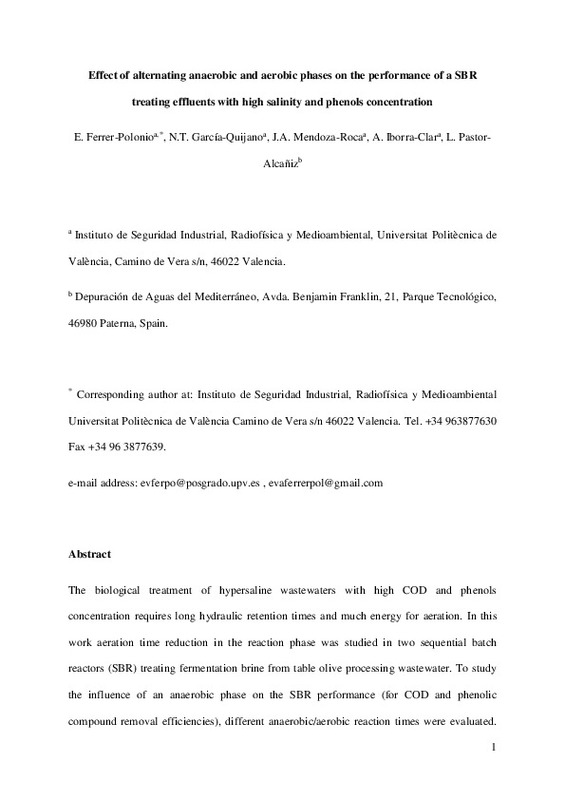JavaScript is disabled for your browser. Some features of this site may not work without it.
Buscar en RiuNet
Listar
Mi cuenta
Estadísticas
Ayuda RiuNet
Admin. UPV
Effect of alternating anaerobic and aerobic phases on the performance of a SBR treating effluents with high salinity and phenols concentration
Mostrar el registro sencillo del ítem
Ficheros en el ítem
| dc.contributor.author | Ferrer-Polonio, Eva
|
es_ES |
| dc.contributor.author | García Quijano, Naurys Tatiana
|
es_ES |
| dc.contributor.author | Mendoza Roca, José Antonio
|
es_ES |
| dc.contributor.author | Iborra Clar, Alicia
|
es_ES |
| dc.contributor.author | Pastor Alcañiz, Laura
|
es_ES |
| dc.date.accessioned | 2017-05-12T08:14:17Z | |
| dc.date.available | 2017-05-12T08:14:17Z | |
| dc.date.issued | 2016-09-15 | |
| dc.identifier.issn | 1369-703X | |
| dc.identifier.uri | http://hdl.handle.net/10251/81039 | |
| dc.description.abstract | The biological treatment of hypersaline wastewaters with high COD and phenols concentration requires long hydraulic retention times and much energy for aeration. In this work aeration time reduction in the reaction phase was studied in two sequential batch reactors (SBR) treating fermentation brine from table olive processing wastewater. To study the influence of an anaerobic phase on the SBR performance (for COD and phenolic compound removal efficiencies), different anaerobic/aerobic reaction times were evaluated. SBR-1 was operated with an anaerobic/aerobic hours ratio of 0/22, 8/14 and 14/8 and SBR-2 with a ratio of 22/0, 14/8 and 8/14. Results showed that the maximum organic matter reduction was obtained under aerobic reaction conditions (ratio 0/22) with a 82.3% and 77.9% of COD and total phenols removal, respectively. However, optimal conditions were considered to prevail for an anaerobic/aerobic ratio of 8/14, since the reactors performances were similar with lower energy consumption. Thus, 82.3% and 79.5% of COD and 77.9% and 78.3% of total phenols were removed in SBR-1 and SBR-2, respectively. | es_ES |
| dc.description.sponsorship | The authors of this work thank the financial support of CDTI (Centre for Industrial Technological Development) depending on the Spanish Ministry of Science and Innovation | en_EN |
| dc.language | Inglés | es_ES |
| dc.publisher | Elsevier | es_ES |
| dc.relation.ispartof | Biochemical Engineering Journal | es_ES |
| dc.rights | Reserva de todos los derechos | es_ES |
| dc.subject | Biological wastewater treatment | es_ES |
| dc.subject | SBR | es_ES |
| dc.subject | Phenolic compounds | es_ES |
| dc.subject | Hypersaline wastewater | es_ES |
| dc.subject | Anaerobic/aerobic phases | es_ES |
| dc.subject.classification | INGENIERIA QUIMICA | es_ES |
| dc.title | Effect of alternating anaerobic and aerobic phases on the performance of a SBR treating effluents with high salinity and phenols concentration | es_ES |
| dc.type | Artículo | es_ES |
| dc.identifier.doi | 10.1016/j.bej.2016.05.010 | |
| dc.rights.accessRights | Abierto | es_ES |
| dc.contributor.affiliation | Universitat Politècnica de València. Escuela Técnica Superior de Ingenieros Industriales - Escola Tècnica Superior d'Enginyers Industrials | es_ES |
| dc.contributor.affiliation | Universitat Politècnica de València. Escuela Técnica Superior de Ingeniería del Diseño - Escola Tècnica Superior d'Enginyeria del Disseny | es_ES |
| dc.contributor.affiliation | Universitat Politècnica de València. Departamento de Ingeniería Hidráulica y Medio Ambiente - Departament d'Enginyeria Hidràulica i Medi Ambient | es_ES |
| dc.description.bibliographicCitation | Ferrer-Polonio, E.; Garcia Quijano, NT.; Mendoza Roca, JA.; Iborra Clar, A.; Pastor Alcañiz, L. (2016). Effect of alternating anaerobic and aerobic phases on the performance of a SBR treating effluents with high salinity and phenols concentration. Biochemical Engineering Journal. 113:57-65. doi:10.1016/j.bej.2016.05.010 | es_ES |
| dc.description.accrualMethod | S | es_ES |
| dc.relation.publisherversion | http://dx.doi.org/10.1016/j.bej.2016.05.010 | es_ES |
| dc.description.upvformatpinicio | 57 | es_ES |
| dc.description.upvformatpfin | 65 | es_ES |
| dc.type.version | info:eu-repo/semantics/publishedVersion | es_ES |
| dc.description.volume | 113 | es_ES |
| dc.relation.senia | 322803 | es_ES |
| dc.contributor.funder | Centro para el Desarrollo Tecnológico Industrial | es_ES |






![[Cerrado]](/themes/UPV/images/candado.png)


